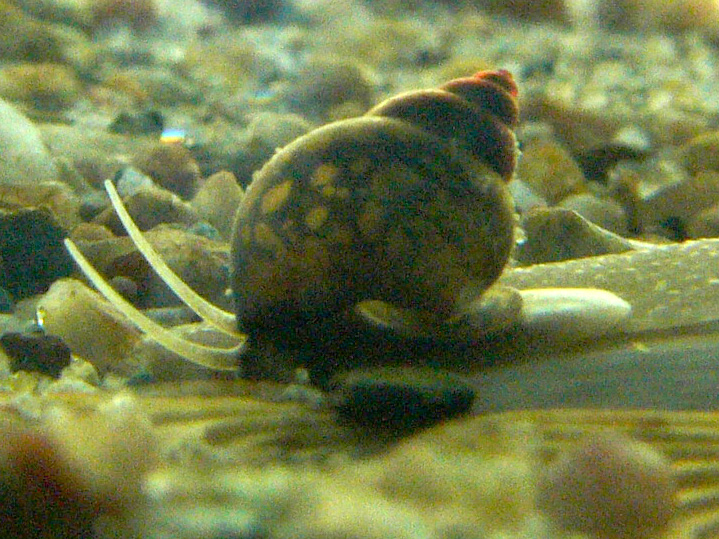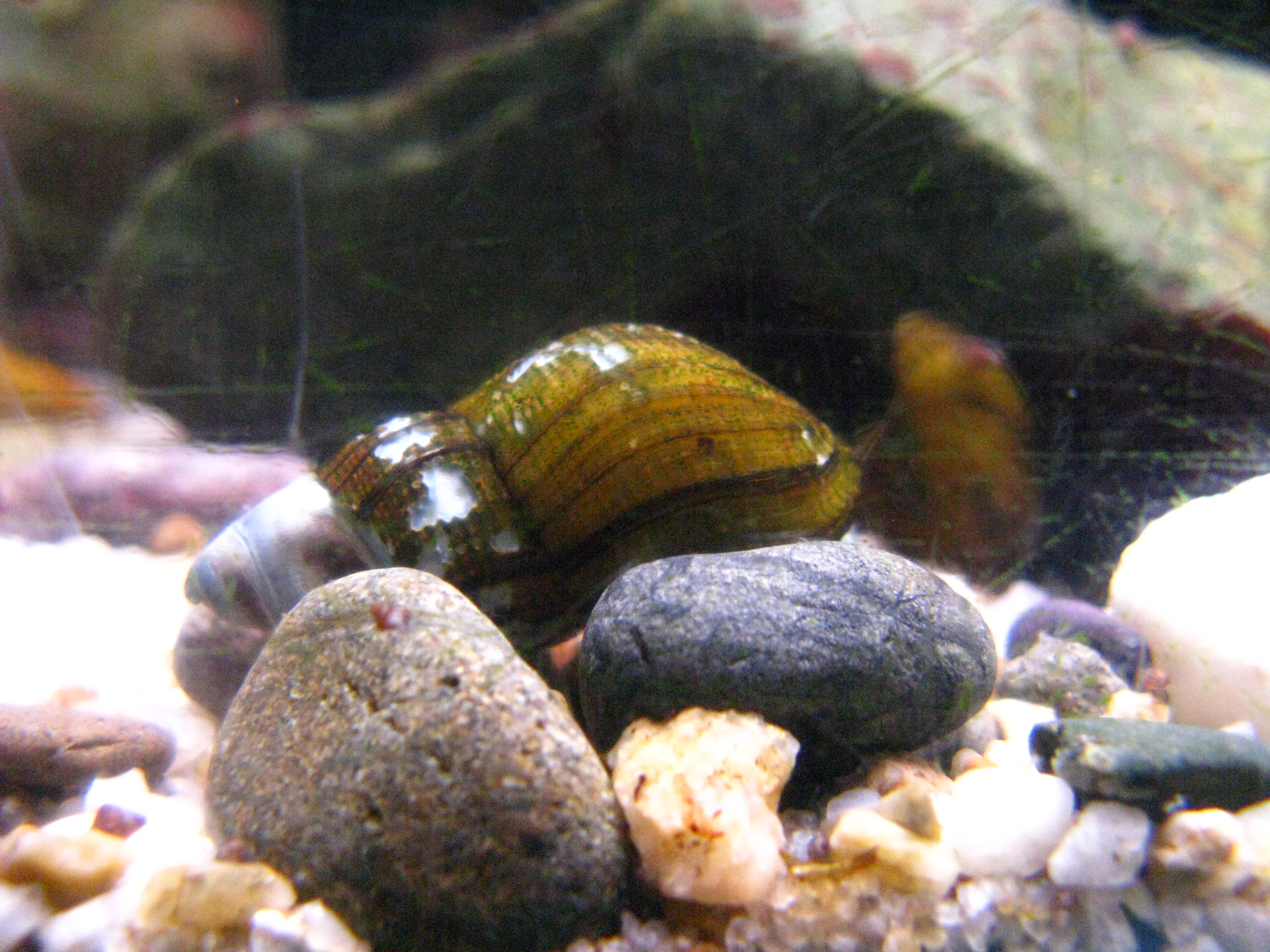|
Semisulcospiridae
Semisulcospiridae, common name semisulcospirids, is a family of freshwater snails, aquatic gilled gastropod mollusks with an operculum, in the superfamily Cerithioidea.MolluscaBase eds. (2021). MolluscaBase. Semisulcospiridae J. P. E. Morrison, 1952. Accessed through: World Register of Marine Species at: http://marinespecies.org/aphia.php?p=taxdetails&id=715954 on 2021-03-08 Semisulcospiridae diversified from the Pleuroceridae about 90 million years ago, in the Cretaceous. Distribution The family Semisulcospiridae occurs in western North America, the Far East of Russia, Korea, Japan, China and Vietnam. Taxonomy The family Semisulcospiridae was introduced as just a name (nomen nudum) by Morrison (1952), without a diagnosis of the taxon. It is a valid taxon however, because its name has been used as valid. 2005 taxonomy According to the taxonomy of Bouchet & Rocroi (2005), Semisulcospiridae was a subfamily within the family Pleuroceridae. 2009 taxonomy The subfamily ... [...More Info...] [...Related Items...] OR: [Wikipedia] [Google] [Baidu] |
Semisulcospira
''Semisulcospira'' is a genus of freshwater snails with an operculum, an aquatic gastropod molluscs in the family Semisulcospiridae.MolluscaBase eds. (2022). MolluscaBase. Semisulcospira O. Boettger, 1886. Accessed through: World Register of Marine Species at: https://www.marinespecies.org/aphia.php?p=taxdetails&id=741120 on 2022-05-23 Species in the genus ''Semisulcospira'' are viviparous.Strong E. & Köhler F. (2009). "Morphological and molecular analysis of "''Melania''" ''jacqueti'' Dautzenberg & Fischer, 1906: from anonymous orphan to critical basal offshoot of the Semisulcospiridae (Gastropoda: Cerithioidea)". ''Zoologica Scripta'' 38(5): 483-502. Species Species within the genus ''Semisulcospira'' include: * '' Semisulcospira arenicola'' Watanabe & Nishino, 1995 * '' Semisulcospira calculus'' (Reeve, 1859) * '' Semisulcospira coreana'' (Martens, 1886) * '' Semisulcospira crassicosta'' Y.-Y. Liu, Y.-X. Wang & Y.-H. Duan, 1994 * '' Semisulcospira davisi'' Sawada & Nakan ... [...More Info...] [...Related Items...] OR: [Wikipedia] [Google] [Baidu] |
Hua (gastropod)
''Hua'' is a genus of freshwater snails with an operculum, an aquatic gastropod mollusks in the family Semisulcospiridae.MolluscaBase eds. (2021). MolluscaBase. Hua S.-F. Chen, 1943. Accessed through: World Register of Marine Species at: http://marinespecies.org/aphia.php?p=taxdetails&id=741123 on 2021-03-09 Species Species within the genus ''Hua'' include: * '' Hua aristarchorum'' (Heude, 1889) * '' Hua aubryana'' (Heude, 1889) * '' Hua bailleti'' (Bavay & Dautzenberg, 1910) * '' Hua diminuta'' (Boettger, 1887) * '' Hua friniana'' (Heude, 1889) * '' Hua funingensis'' L.-N. Du, Köhler, X.-Y. Chen & J.-X. Yang, 2019 * '' Hua jacqueti'' (Dautzenberg & H. Fischer, 1906) * '' Hua kunmingensis'' L.-N. Du, Köhler, G.-H. Yu, X.-Y. Chen & J.-X. Yang, 2019 * '' Hua liuii'' L-N. Du, Köhler, G.-H. Yu, X.-Y. Chen & J.-X. Yang, 2019 * '' Hua oreadarum'' (Heude, 1889) * '' Hua praenotata'' (Gredler, 1884) * '' Hua scrupea'' (Fulton, 1914) * '' Hua tchangsii'' L-N. Du, Köhler, G.-H. Yu, X.- ... [...More Info...] [...Related Items...] OR: [Wikipedia] [Google] [Baidu] |
Cerithioidea
The Cerithioidea is a Taxonomic rank, superfamily of marine, brackish water and freshwater Gastropoda, gastropod containing more than 200 genera. The Cerithioidea are included unassigned in the subclass Caenogastropoda. The original name of this superfamily was Cerithiacea, in keeping with common superfamily endings at the time. Ecology Cerithioidea is a very diverse superfamily. Its species can be found worldwide mainly in Tropics, tropic and subtropic seas on rocky Intertidal zone, intertidal shores, seagrass beds and algal fronds, but also in estuarine and freshwater habitats. The freshwater species are found on all continents, except Antarctica. They are dominant members of mangrove forests, estuarine mudflats, fast-flowing rivers and placid lakes.Healy J. M. & Wells F. E. (). ''Mollusca, The Southern Syntthesis. Fauna of Australia.'' Melbourne, CSIRO publishing. 707 pp. Fossil record Their fossil record of this superfamily can be traced back as far as the early TriassicT ... [...More Info...] [...Related Items...] OR: [Wikipedia] [Google] [Baidu] |
Juga
''Juga'' is a genus of freshwater snails with a gill and an operculum, aquatic gastropod mollusks in the family Semisulcospiridae. These snails are native to the rivers of the northwestern United States and adjacent British Columbia. Several species are endemic to isolated large springs in the American Great Basin.Strong, E. E., & Whelan, N. V. (2019). Assessing the diversity of western North American Juga (Semisulcospiridae, Gastropoda). Molecular Phylogenetics and Evolution, 136, 87-103. The most abundant and widespread species, ''Juga plicifera'', attains a height of up to 35 mm. It is sculpted with fine spiral ridges and variably developed ribs that frequently disappear in parts of the shell made as the animal matures. Species The following species and subspecies are recognized: Subgenus ''Juga'' s.s. * '' Juga hemphilli'' (J. Henderson, 1935) ** ''Juga hemphilli dallesensis'' (J. Henderson, 1935) ** ''Juga hemphilli maupinensis'' (J. Henderson, 1935) * '' Juga pl ... [...More Info...] [...Related Items...] OR: [Wikipedia] [Google] [Baidu] |
Pleuroceridae
Pleuroceridae, common name pleurocerids, is a family of small to medium-sized freshwater snails, aquatic gilled gastropod mollusks in the superfamily Cerithioidea.These snails have an operculum and typically a robust high-spired shell. Reproduction is iteroparous, and juvenile snails emerge from eggs laid on a firm surface by a gonochoristic female. There is no veliger stage. Evolution There is very high level of mitochondrial heterogeneity in apparent species of Pleuroceridae (highest among gastropods, also with Semisulcospiridae), that has not been sufficiently explained yet as of 2015. However, it has been suggested that this may be due to pleurocerids having very poor dispersal abilities, allowing even slightly separated populations to see great genetic divergence. Populations of the pleurocerid species in the Old Appalachians (Virginia south to Georgia) are present on both sides of the Eastern Continental Divide, but there is no difference in the extent of intrapopulat ... [...More Info...] [...Related Items...] OR: [Wikipedia] [Google] [Baidu] |
Freshwater Snail
Freshwater snails are gastropod mollusks that live in fresh water. There are many different families. They are found throughout the world in various habitats, ranging from ephemeral pools to the largest lakes, and from small seeps and springs to major rivers. The great majority of freshwater gastropods have a gastropod shell, shell, with very few exceptions. Some groups of snails that live in freshwater Respiratory system, respire using gills, whereas Pulmonata, other groups need to reach the surface to breathe air. In addition, some are amphibious and have both gills and a lung (e.g. ''Ampullariidae''). Most feed on algae, but many are detritivores and some are Filter feeding, filter feeders. Freshwater snails are indirectly among the deadliest animals to humans, as they carry parasitic worms that cause schistosomiasis, a disease estimated to kill between 10,000 and 200,000 people annually. There are thousands of known species, and at least 33–38 independent Lineage (evolut ... [...More Info...] [...Related Items...] OR: [Wikipedia] [Google] [Baidu] |
Semisulcospira Kurodai
''Semisulcospira kurodai'' is a species of freshwater snail with an operculum (gastropod), operculum, an aquatic gastropod mollusc in the family Semisulcospiridae. Before 2009, this species was classified in the family Pleuroceridae. Description The maximum width of the shell of ''Semisulcospira kurodai'' is and in height in the laboratory. The maximum weight of the animal in the laboratory is . The width of the shell is in the first year, in the second year, in the third year and in the fourth year in the laboratory. The diploid chromosome number of ''Semisulcospira kurodai'' is 2n=35 and 2n=36 (both chromosome numbers were observed).Davis G. M. (1969). "A taxonomic study of some species of ''Semisulcospira'' in Japan (Mesogastropoda: Pleuroceridae)". ''Malacologia'' 7211294. Distribution This species occurs in List of non-marine molluscs of Japan, Japan. Ecology Habitat ''Semisulcospira kurodai'' lives in rivers and in ponds. Life cycle The female has 17 to 72 embry ... [...More Info...] [...Related Items...] OR: [Wikipedia] [Google] [Baidu] |
Operculum (gastropod)
An operculum (; ) is a corneous or calcareous anatomical structure like a trapdoor that exists in many (but not all) groups of sea snails and freshwater snails, and also in a few groups of land snails, including the Helicinidae, Cyclophoridae, Aciculidae, Maizaniidae, Pomatiidae, etc. The operculum is attached to the upper surface of the foot and in its most complete state, it serves as a sort of "trapdoor" to close the aperture (mollusc), aperture of the shell when the soft parts of the animal are retracted. The shape of the operculum varies greatly from one family of gastropods to another. It is fairly often circular, or more or less oval in shape. In species where the operculum fits snugly, its outline corresponds exactly to the shape of the aperture (mollusc), aperture of the shell and it serves to seal the entrance of the shell. Many families have opercula that are reduced in size, and which are not capable of closing the shell aperture. Opercula have sometimes been modifie ... [...More Info...] [...Related Items...] OR: [Wikipedia] [Google] [Baidu] |
Taxonomy Of The Gastropoda (Bouchet & Rocroi, 2005)
The taxonomy of the Gastropoda as it was revised in 2005 by Philippe Bouchet and Jean-Pierre Rocroi is a system for the scientific classification of gastropod mollusks (Gastropods are a taxonomic class of animals which consists of snails and slugs of every kind, from the land, from freshwater, and from saltwater). The paper setting out this taxonomy was published in the journal '' Malacologia''. The system encompasses both living and extinct groups, as well as some fossils whose classification as gastropods is uncertain. The Bouchet & Rocroi system was the first complete gastropod taxonomy that primarily employed the concept of clades, and was derived from research on molecular phylogenetics; in this context a clade is a "natural grouping" of organisms based upon a statistical cluster analysis. In contrast, most of the previous overall taxonomic schemes for gastropods relied on morphological features to classify these animals, and used taxon ranks such as order, superorder ... [...More Info...] [...Related Items...] OR: [Wikipedia] [Google] [Baidu] |
Type Genus
In biological taxonomy, the type genus (''genus typica'') is the genus which defines a biological family and the root of the family name. Zoological nomenclature According to the International Code of Zoological Nomenclature, "The name-bearing type of a nominal family-group taxon is a nominal genus called the 'type genus'; the family-group name is based upon that of the type genus." Any family-group name must have a type genus (and any genus-group name must have a type species, but any species-group name may, but need not, have one or more type specimens). The type genus for a family-group name is also the genus that provided the stem to which was added the ending -idae (for families). :Example: The family name Formicidae has as its type genus the genus ''Formica'' Linnaeus, 1758. Botanical nomenclature In botanical nomenclature, the phrase "type genus" is used, unofficially, as a term of convenience. In the '' ICN'' this phrase has no status. The code uses type specimens ... [...More Info...] [...Related Items...] OR: [Wikipedia] [Google] [Baidu] |
Family (biology)
Family (, : ) is one of the eight major hierarchical taxonomic ranks in Linnaean taxonomy. It is classified between order and genus. A family may be divided into subfamilies, which are intermediate ranks between the ranks of family and genus. The official family names are Latin in origin; however, popular names are often used: for example, walnut trees and hickory trees belong to the family Juglandaceae, but that family is commonly referred to as the "walnut family". The delineation of what constitutes a family—or whether a described family should be acknowledged—is established and decided upon by active taxonomists. There are not strict regulations for outlining or acknowledging a family, yet in the realm of plants, these classifications often rely on both the vegetative and reproductive characteristics of plant species. Taxonomists frequently hold varying perspectives on these descriptions, leading to a lack of widespread consensus within the scientific community ... [...More Info...] [...Related Items...] OR: [Wikipedia] [Google] [Baidu] |




